#14 in Vietnam
Bún Riêu Cua: Basic Information
Pronunciation
Alternative Name(s)
Dish Type
Course
Mealtime
Popular Bún Riêu Cua Variations

Bún Riêu Cua Đồng

Bún Riêu Cua Biển
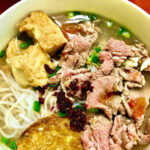
Bún Riêu Cua Bắp Bò
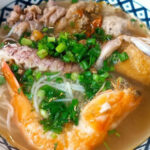
Bún Riêu Cua Bề Bề

Bún Riêu Cua Ốc
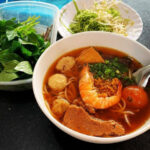
Bún Riêu Tôm
Bún Riêu Cua: Ingredients and Preparation
Main Ingredients
Main Cooking Method
Preparation Process
Bún Riêu Cua: A Deep Dive
Cultural Significance
Taste
Texture
Aroma
Color
Serving Style
Serving Temperature
Accompaniment
Occasions
Seasons
Special Diets
Calories
Popularity
Popular Similar Dishes
- Bánh canh
- Bún Ốc
- Canh Bún
- Bánh Canh Cua
- Crab bee hoon
Popular Dining Area
Bún riêu cua, or shortly bun rieu, is a traditional Vietnamese noodle soup known for its distinctive and flavorful tomato broth, which is enriched with crab and shrimp paste.
The dish features rice vermicelli noodles, which are called “bún,” and the “riêu” refers to the crab cake that is typically made from a mixture of ground rice paddy crabs.
It is often garnished with fresh herbs, like coriander and perilla, bean sprouts, chopped green onions, and served with a side of lime and chili to enhance its flavor.
Bún riêu cua is celebrated for its complex and satisfying combination of sweet, savory, and tart notes, and is a staple in Vietnamese cuisine.
Let me guide you through the dish’s features, its roots, component details, variations, the best ways to eat it, where you can find it, its good and not-so-good points, how bún riêu cua is different from canh bún, and dishes that are kind of like it.
Key Points
Bún Riêu Cua Images
Where Is Bun Rieu Cua from?
Bún riêu is a traditional Vietnamese soup with a distinctive sour flavor that originates from the country’s northern region.
The exact historical origins of Bun Rieu are not well documented, as is the case with many traditional dishes worldwide. It likely evolved over time from local ingredients and cooking techniques.
As with many Vietnamese dishes, regional variations exist. For example, in the southern part of Vietnam, Bun Rieu includes a greater variety of ingredients.
What’s in Bún Riêu Cua?
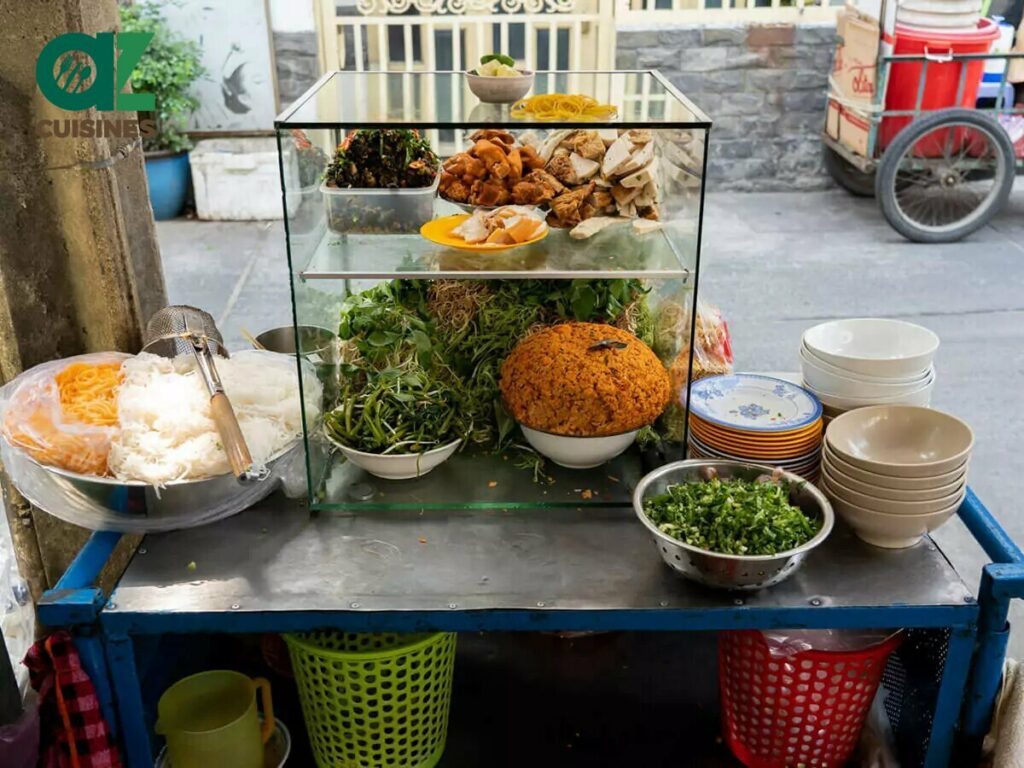
Here are the typical ingredients in a classic bún riêu cua:
| Ingredients | Description |
|---|---|
| Riêu (Crab Mixture) | Rice paddy crabs crab paste or minced crab Ground pork (optional) Eggs (optional) Dried shrimp (optional) |
| Broth | Tomatoes (freshly chopped or canned) Chicken or pork bones (for the stock) Onion Shallots Garlic Annatto seeds or oil (for coloring) Tamarind paste or vinegar (for a sour note) Water or stock |
| Aromatics and Spices | Lemongrass (bruised) Fish sauce Salt Sugar Chili pepper or chili sauce |
| Noodles | Bún (rice vermicelli noodles) |
| Herbs and Garnishes | Fresh herbs (typically a combination of cilantro, perilla, mint, and Vietnamese balm) Bean sprouts Lime wedges Sliced banana blossom Deep-fried tofu (optional) Blood cubes (optional) Green onions and cilantro for topping Shredded morning glory (optional) |
| Accompaniments | Fish sauce Shrimp paste Chili paste or fresh chilies Lime wedges Tamarind sauce (optional) |
The variety of components listed provides a glimpse into the complex and customizable nature of bún riêu cua, highlighting the dish’s ability to embrace regional variations and personal touches.
What Are Different Variations of Bún Riêu Cua?
Bún riêu cua varies by region, with the Northern and Southern versions. Moreover, there are also 13 variations by ingredients as explained below:
Variations by Region
Here’s a comparative table outlining the differences between the Northern and Southern versions of bún riêu cua:
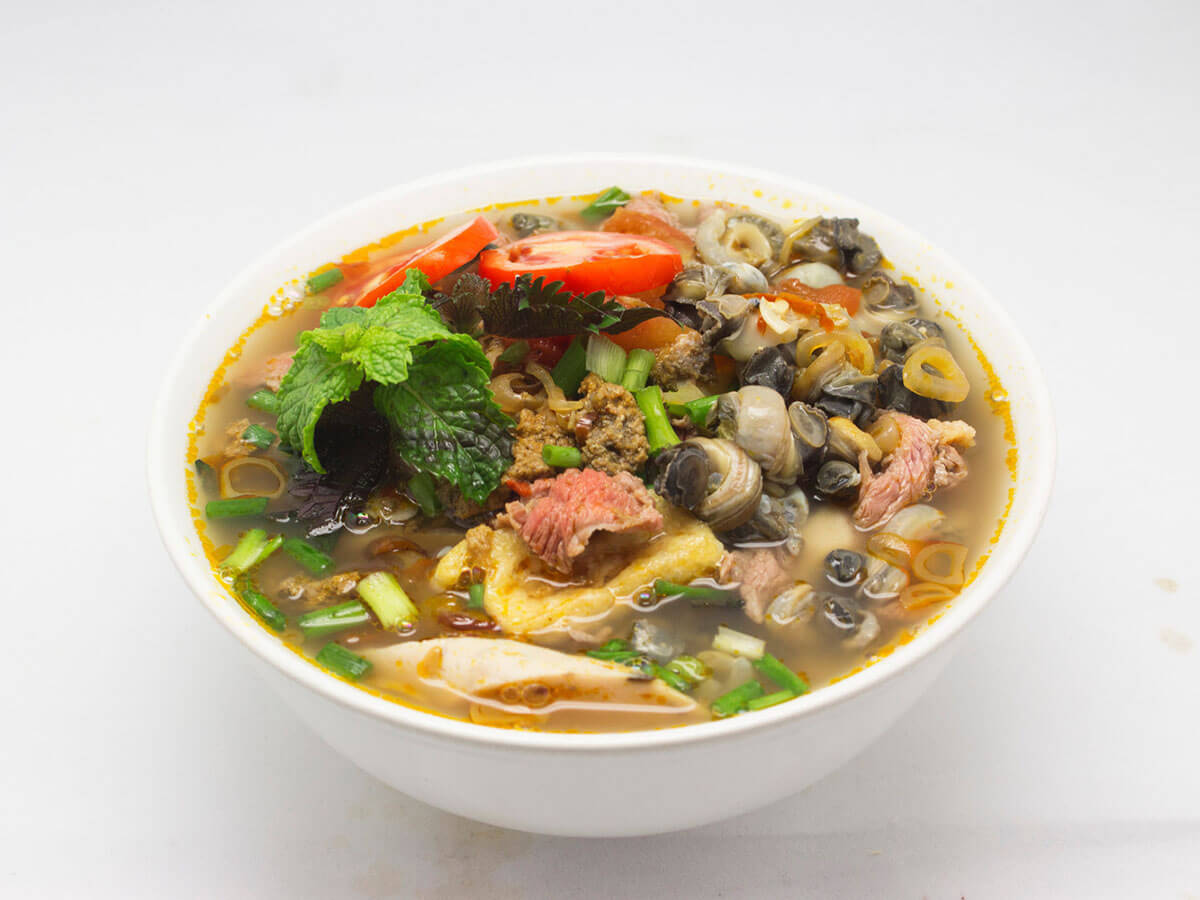
Northern Bún Riêu Cua
Base Flavor: Simpler taste, highlighting the natural sweetness and purity of the crab meat.
Color: Less emphasis on the color of the broth.
Ingredients: Primarily features small rice noodles, rice paddy crabs, tomatoes, fermented rice vinegar (giấm bỗng), shrimp paste, and onions.
Broth Preparation: Crab paste is fried with onions and combined with a boiling crab liquid along with tomatoes and other seasonings.
Toppings: Traditional toppings may include raw beef and fresh shrimp, with newer additions like snails and baluts (trứng vịt lộn).
Seasonal Suitability: Considered refreshing in summer and warming in winter, adaptable with the addition of chili.
Eating Experience: Often enjoyed at street food stalls, providing a cultural and urban atmosphere.
Culinary Approach: Historically more conservative, focusing on the clarity of individual flavors.
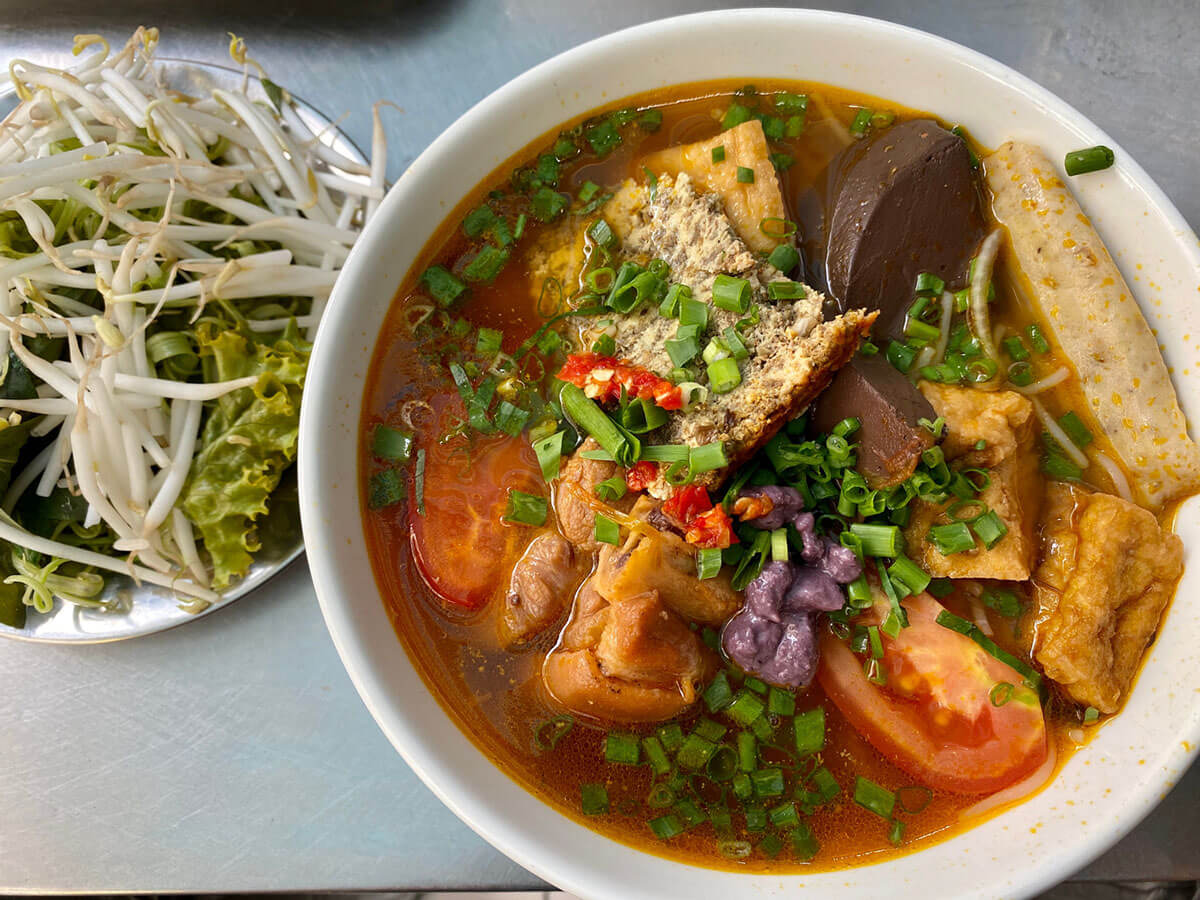
Southern Bún Riêu Cua
Base Flavor: Richer and sweeter broth from crabs and pork ribs.
Color: Reddish-orange hue from sautéed tomatoes and sometimes annatto seeds for color.
Ingredients: Includes a wider variety, such as crab paste, fried tofu, pig’s blood pudding, and sometimes premium seafood.
Broth Preparation: Broth is enhanced with annatto oil, and the crab paste includes egg yolk and ground meat for a thicker consistency.
Toppings: A diverse array that may include pig’s blood pudding, pig’s feet, fish cake, beef sausage, pork sausage, shrimp patties, squid cakes, etc.
Seasonal Suitability: Similarly enjoyed in all seasons, with the same ability to adjust for summer refreshment or winter warmth.
Eating Experience: Found at various food stalls with diverse preparations, reflecting a blend of culinary influences.
Culinary Approach: Less concerned with tradition, more open to contemporary influences and diverse ingredients.
Variations by Ingredients and Cooking Methods
Below is a table that outlines the variations of bún riêu cua by ingredients and cooking methods, focusing on the main ingredients (including tomato and crab-based broth), and their characteristics:
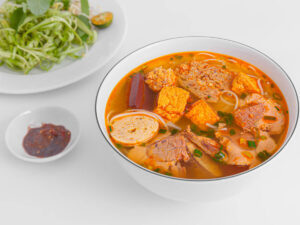
Bún Riêu Cua Đồng
Has a more delicate and sweet taste from the rice paddy crab.
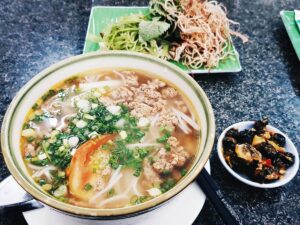
Bún Riêu Cua Biển
Features a distinct seafood flavor with fresh and briny notes.

Bún Riêu Cua Bắp Bò
Combines the richness of beef with the sweetness of crab.

Bún Riêu Cua Bề Bề
Offers a unique texture and flavor from the mantis shrimp.
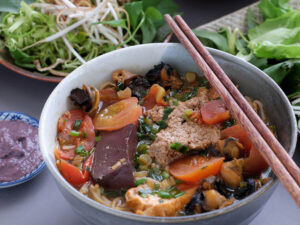
Bún Riêu Cua Ốc
Known for its chewy texture and a mix of seafood and earthy tastes.

Bún Riêu Tôm
Highlighted by the sweet and succulent flavor of shrimp.

Bún Riêu Tôm Khô
Features the concentrated and intense flavor of dried shrimp, offering a deeper umami taste compared to fresh shrimp
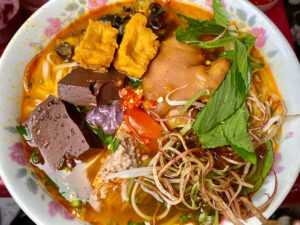
Bún Riêu Giò Heo
Features the gelatinous and rich texture of pork trotters.

Bún Riêu Chả Cá
Known for its firm texture and mild, sweet fish flavor.
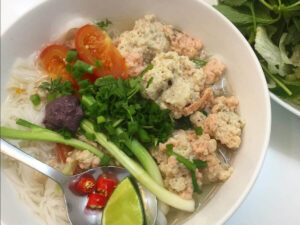
Bún Riêu Ghẹ
Rich in crab flavor, with the luxury of crab roe and sometimes the sweetness of soft-shelled crab.

Bún Riêu Vịt
Characterized by the savory depth that duck meat provides to the broth.
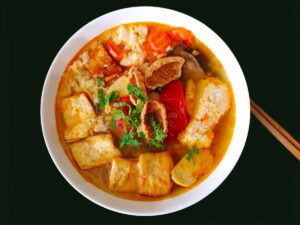
Bún Riêu Chay
A vegetarian version, often with a lighter and herbal flavor profile.
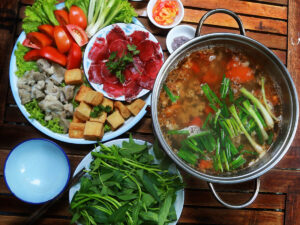
Lẩu Riêu Cua
A communal hot pot with a rich and tangy broth. The flavor is robust with the essence of crab and the brightness of tomatoes, often accentuated with the same spices and aromatics found in the classic bún riêu cua.
Exploring these variations reveals a tapestry of flavors and textures that can enhance the dining experience, offering myriad ways to relish and savor this iconic Vietnamese dish.
How to Enjoy Bún Riêu Cua?
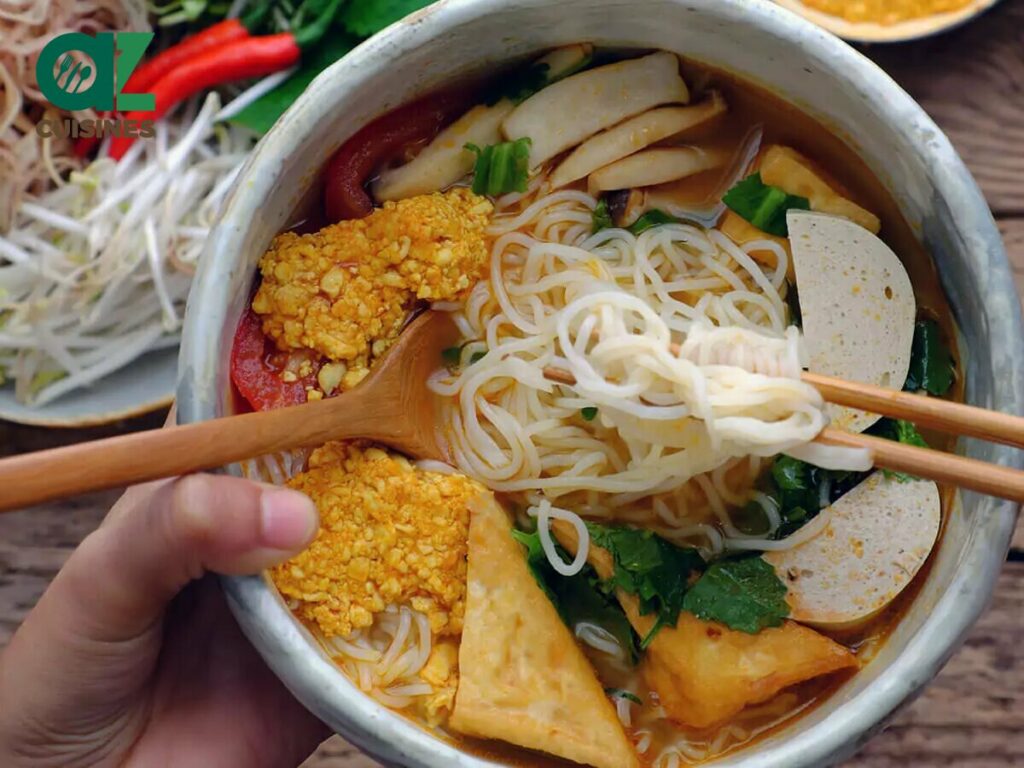
Here’s how to enjoy bún riêu cua:
- Get the Right Utensils: A soup spoon and a pair of chopsticks will be your tools for this culinary adventure.
- Savor the Broth First: Taste the soup first to appreciate the flavor of the broth before you start mixing in other ingredients.
- Adjust Your Seasonings: You’ll often find on the table a range of condiments and additions such as lime wedges, fresh herbs (like cilantro, basil, or perilla), bean sprouts, sliced chilies, and shrimp paste. Add these to your taste. A squeeze of lime can add a nice zest to the soup.
- Adjust The Shrimp Paste Mixture: You can add a bit of lime juice (or tamarind water) and a little sugar to the shrimp paste, then stir evenly with chopsticks. You can also add some ground chili or sliced chili if you like it spicy. The shrimp paste is used to dip various toppings when eating bún riêu.
- Mix It Up: Use your chopsticks to stir the noodles, proteins (like tofu, crab cakes, or shrimp), and herbs together. This will ensure that you get a bit of every ingredient in each spoonful.
- Eat in Combination: Use your chopsticks to grab some noodles and herbs, place them in your spoon, and then scoop up some broth. This way, you’ll experience a combination of textures and flavors all at once.
- Sip the Broth: In between bites, use your spoon to sip the broth.
- Fresh Herbs and Vegetables: Typically, Bún Riêu Cua is served with a plate of fresh herbs, sliced banana blossom, perilla leaves, or shredded water spinach. You can either add these to the soup or eat them on the side, occasionally taking a bite to refresh your palate.
- Take Your Time: Bún Riêu Cua is not only nourishment but also a culinary experience. Don’t rush through it; take the time to enjoy the complex flavors and the ritual of eating.
- Slurping is Fine: In many Asian cultures, slurping is not considered rude; it’s a sign that you’re enjoying your meal. So, don’t be shy about slurping your noodles!
To truly embrace the essence of this Vietnamese classic, seek out local street food stalls or authentic Vietnamese restaurants.
Where To Try Bún Riêu Cua?
To try an authentic bowl of bún riêu cua, here are some suggestions on where to go:
In Hanoi
Bún riêu cua Tuấn Anh
Address: 37 Hồng Mai, Bạch Mai Ward, Hai Bà Trưng District, Hanoi
Bún riêu cua Hàng Bạc
Address: 11 Hàng Bạc Street, Hoàn Kiếm District, Hanoi
Bún Riêu Huyền Thu
Address: 2F Quang Trung Street, Trần Hưng Đạo, Hoàn Kiếm District, Hanoi
In Ho Chi Minh City
Bún Riêu 7
Address: 122 Hậu Giang Street, Ward 6, District 6, Ho Chi Minh City
Bún riêu Gánh chợ Bến Thành
Address: 163 Lê Thánh Tôn Street, Bến Thành Ward, District 1, Ho Chi Minh City
Bún Riêu GỐC – Nguyễn Cảnh Chân
Address: TK18/5 Nguyễn Cảnh Chân Street, Cầu Kho Ward, District 1, Ho Chi Minh City
Exploring these renowned spots for bún riêu cua not only promises a culinary delight but also provides a chance to weigh the advantages and drawbacks of this traditional dish’s rich flavors and unique textures.
Pros and Cons of Eating Bún Riêu Cua
Here are some pros and cons associated with bún riêu cua from various perspectives:
Pros
Cons
While bún riêu cua’s distinct flavors and cultural significance, it also requires consideration of the preparation time and palatability, all of which underscore the similarities and differences it shares with other Vietnamese noodle dishes such as canh bún.
Bún Riêu Cua vs. Canh Bún
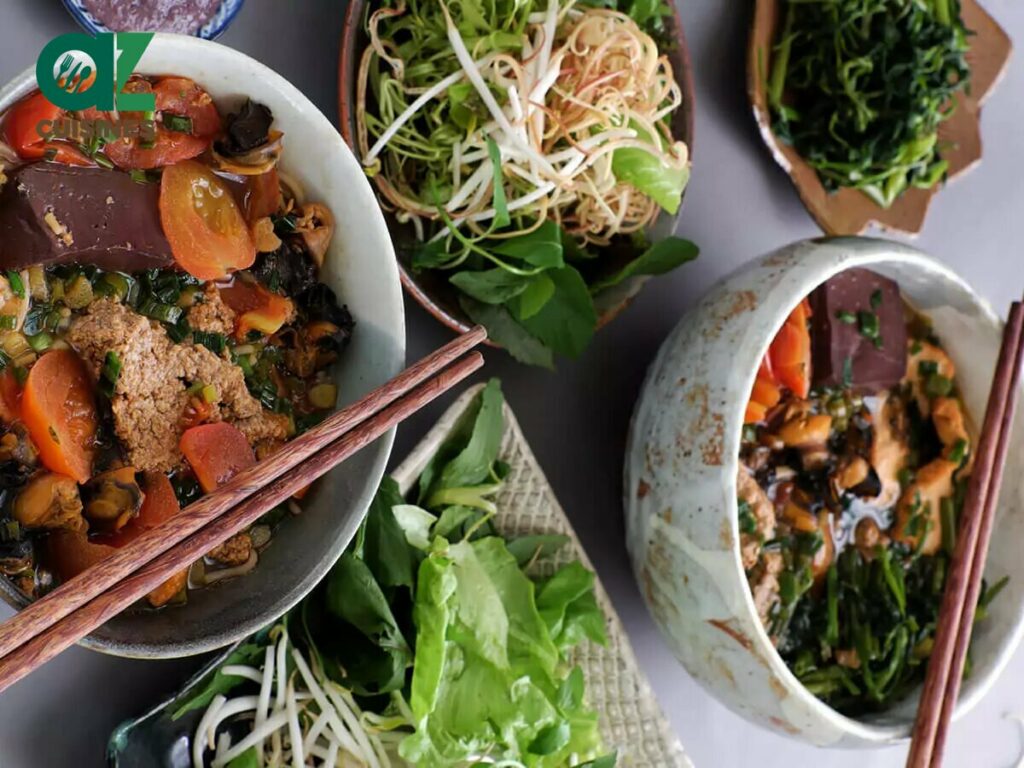
Similarities
Bún riêu cua and canh bún are both popular dishes in Vietnamese cuisine, and they share 3 similarities:
- Origin: Both dishes originate from Northern Vietnam.
- Main Ingredient: The primary ingredient in both is rice paddy crab, which is used to create the flavor base of the broth.
- Noodle Soup: They are both noodle soup dishes served with a broth made from field crab and noodles.
Despite these similarities, there are also differences that make each dish unique.
Differences
There are 4 distinct differences that set bún riêu cua and canh bún apart:
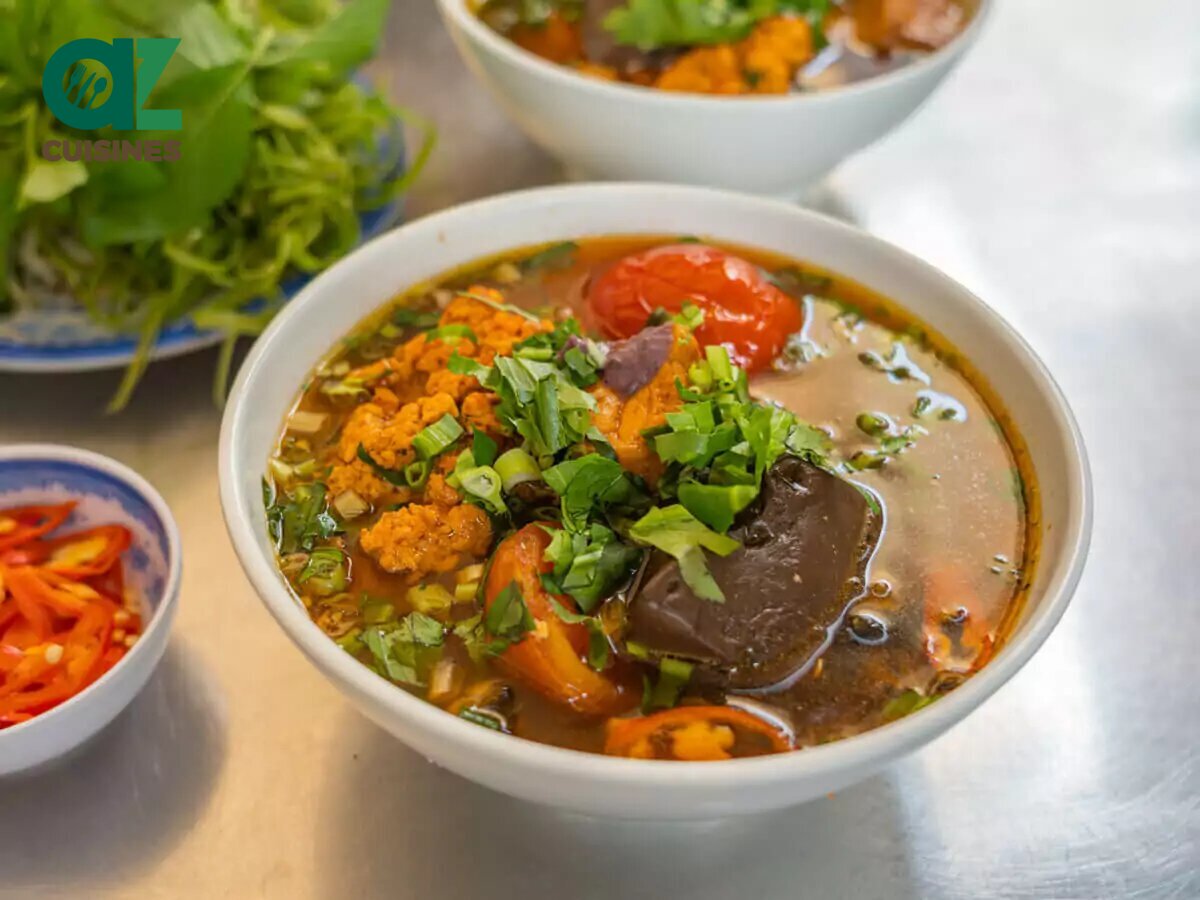
Bún Riêu Cua
Noodle Type: Thinner strands of rice vermicelli commonly used
Accompaniments: Served with raw herbs and bean sprouts
Broth Character: Sour taste from tomatoes or tamarind
Broth Color: Reddish hue from tomatoes

Canh Bún
Noodle Type: Thick strands of rice vermicelli
Accompaniments: Typically served with boiled water spinach
Broth Character: Pure flavor of rice paddy crab
Broth Color: Distinctive pale orange color from rice paddy crab
There’s also a wealth of info in the FAQs section – don’t miss it.



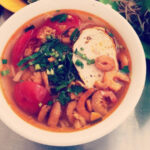
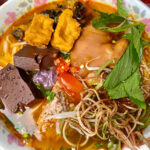
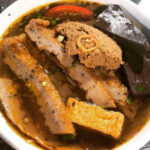
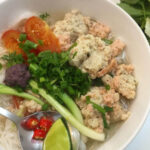
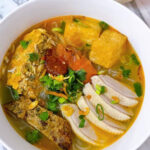

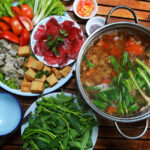

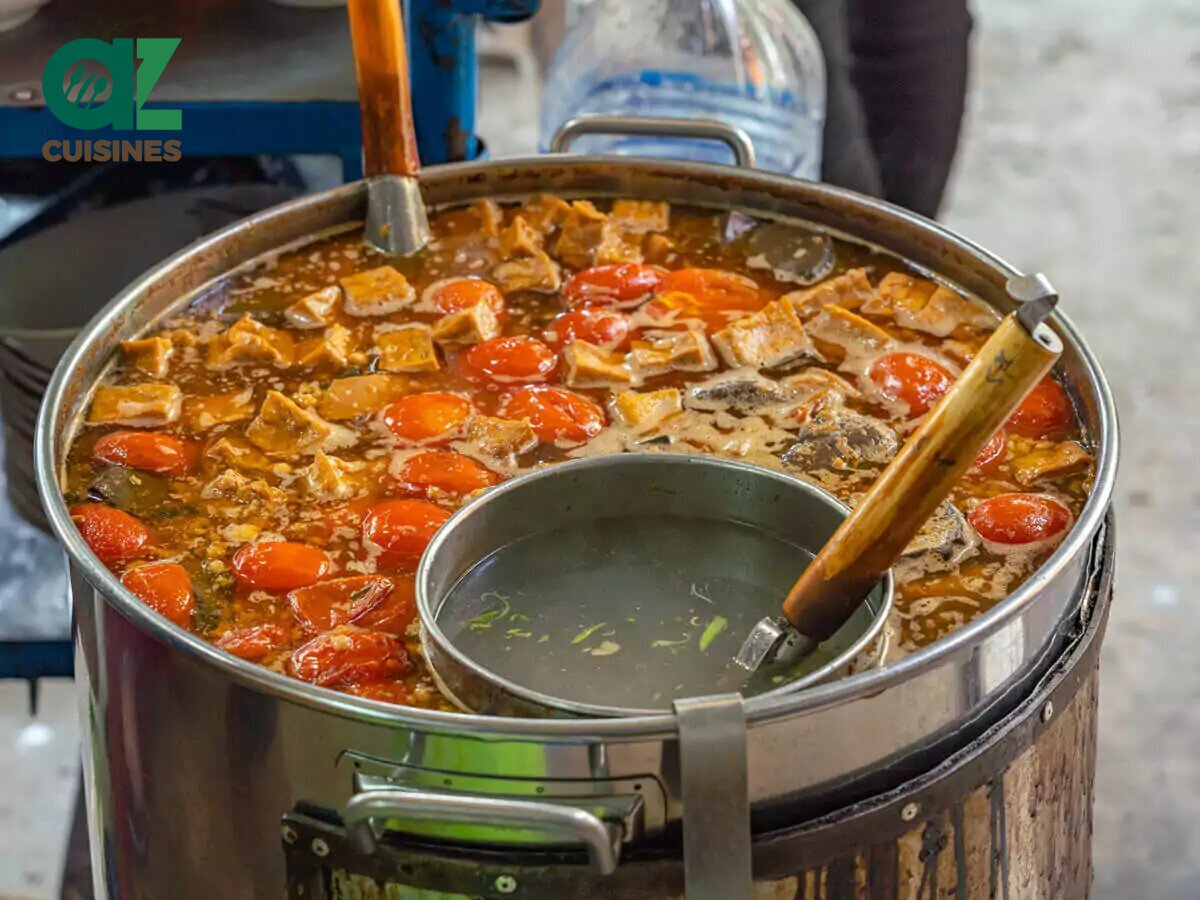

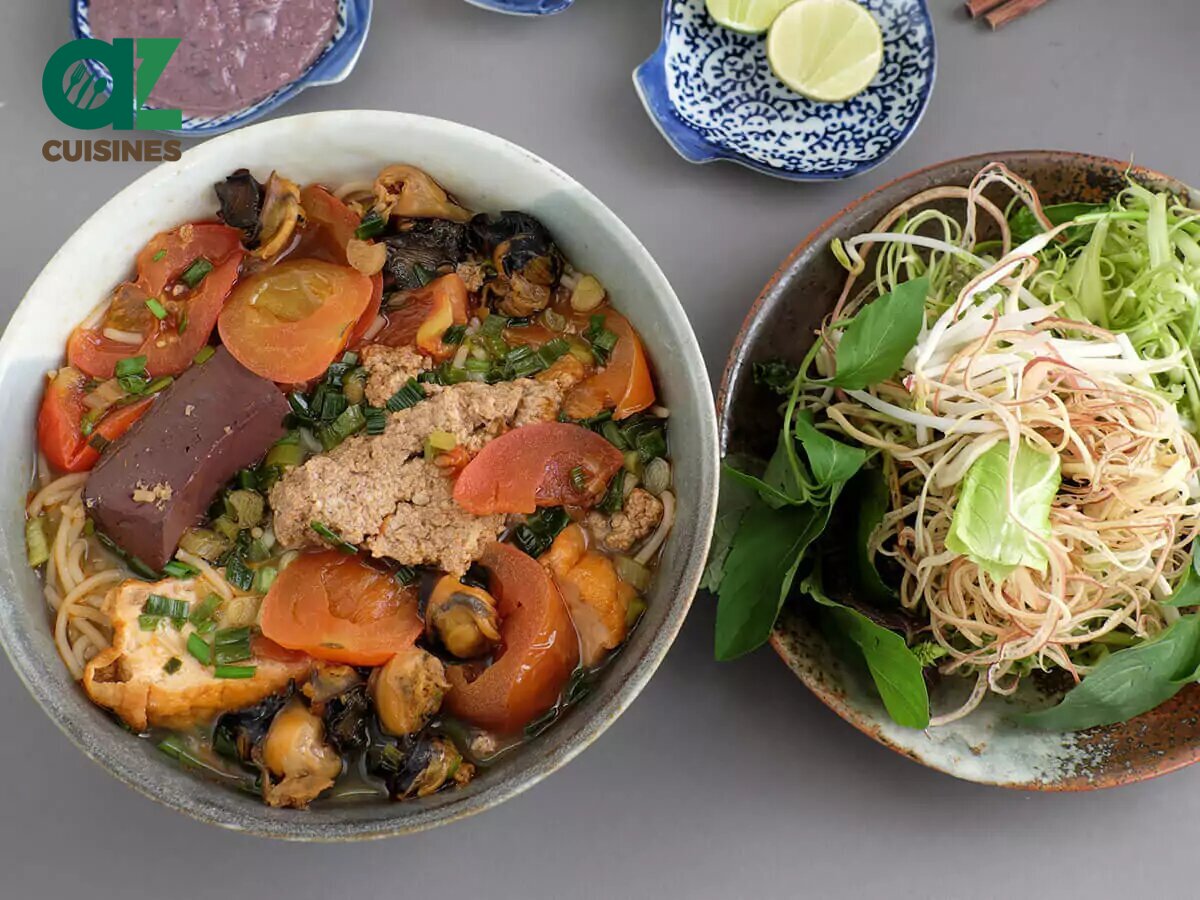
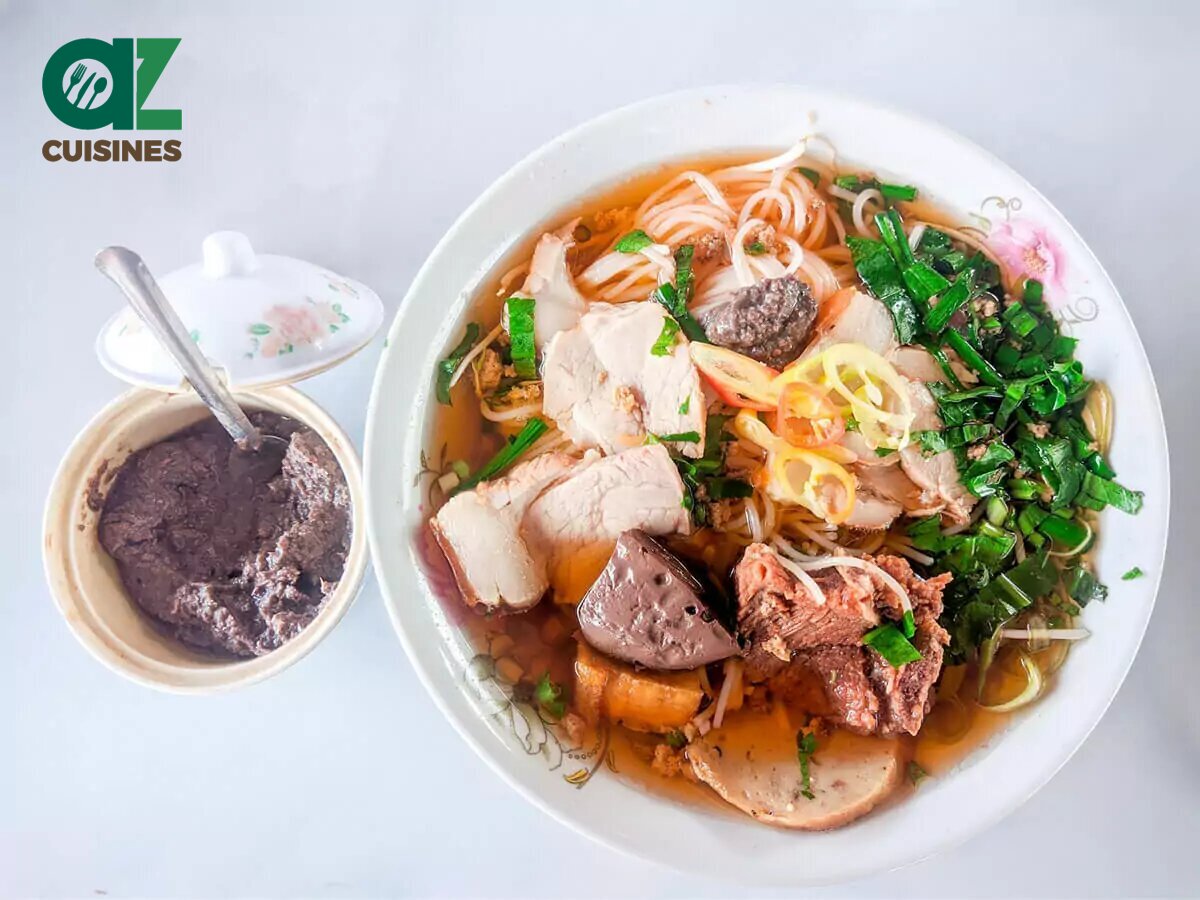




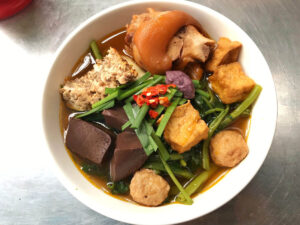

Truc Tran (Kris)
Senior Food Editor
Expertise
Home Cooking, Meal Planning, Recipe Development, Baking and Pastry, Food Editor, Cooking-video Maker, Vietnamese Food Evaluation Expert
Education
Truc Tran (Kris), an experienced food writer and editor, is great at exploring and describing global cuisines, from simple street food to fancy dining. In her writing, she skillfully mixes different flavors, cooking methods, and culinary traditions, showing the unique character of various cultures through their food and drinks. On azcuisines.com, Kris highlights her knowledge, especially in Asian cuisine and worldwide traditional dishes.